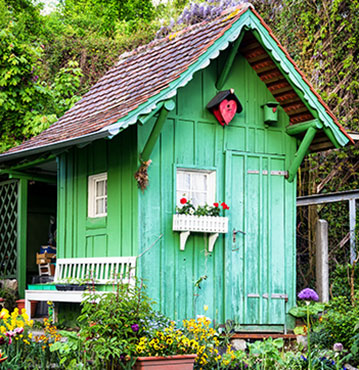 The man cave is now such a ubiquitous part of modern popular culture that it is almost taken for granted. The image of blokes tinkering in their garage, woodshop, or other designated area with the caveat that all others should stay out of their sacred space seems to be entrenched in what the idea of this modern living space should be.
The man cave is now such a ubiquitous part of modern popular culture that it is almost taken for granted. The image of blokes tinkering in their garage, woodshop, or other designated area with the caveat that all others should stay out of their sacred space seems to be entrenched in what the idea of this modern living space should be.
But the latest decorating trend is an uber-feminine answer to the man cave; the “she shed.” Women are purchasing large garden sheds or tiny houses, perching them in a corner of their back yard and then turning them into an extension to be used as their own private retreat. She-sheds are becoming their own kind of domestic status symbol, where no expense is spared to create a showy masterpiece that exudes deliberate executions of interior design. The ones that make the pages of design magazines display a plethora of pretty things and come packaged in ruffles and pastels?and if the rest of the family doesn’t like it, then so be it. They symbolize the home equivalent of spa days; the domestic goddess version of crafting or sewing rooms ramped up a thousand times. An internet search comes up with thousands of examples, some more over-the-top than others.
But the concept of private, individual spaces within a home isn’t new. Throughout history, there have been areas of segregated living within homes. Ancient Greco-Roman cultures offered distinct living areas for women, men, and servants in addition to common areas. Later, in upper-class England (think Downtown Abbey), women had their own private retreats, ranging from separate dressing rooms to ladies? parlours where the lady of the house could entertain invited company, oversee the housekeeping budget and write the letters that were a vital form of communication with the outside world.
Even the idea of the man cave is not new. In Kuwait, for instance, many homes contain a diwaniya, where men can retreat during the evening to a dedicated reception room or annex area to receive guests, smoke, and discuss pertinent news. This practice may be based on a Bedouin tradition going back centuries.
But let’s back up just a little bit and take the whole gender factor out of the equation. The concept of a personal sanctuary or retreat is not just an upper-class concept or a luxury. Modern life is increasingly becoming rushed, and having a personal space to retreat to is, just as increasingly, being viewed as a vital antidote to stress. Having a place to refresh, recover, and then reengage, even for a short period of time, is often a necessity. But most living environments do not incorporate spots to “just be”, and pride themselves in every space being able to be used in a myriad of multitasking ways. But having one spot in the house to just decompress is a great idea for both men and women, especially for those who are going through a major transition such as a career change, or trying to better themselves through university studies. A personal retreat is a way to take a step back and just “be” for a moment.
If the idea of creating your own personal space is appealing, don’t feel that it isn’t worthy if it doesn’t compete with the examples on the internet, or that the space has to be completely separate from the rest of the house. Not everyone has the luxury of space. The great thing about a personal sanctuary is that it can be as small as a closet or corner in an apartment, or a far-away area of a basement located off the utility room. It can also be a temporary partition, easily disassembled like a piece of flat-pack furniture.
Here are some elements to consider in creating your own personal retreat. However, they are just a starting point for your own creativity and so are not “rules”. But let’s get one thing clear: a sanctuary does not have to have religious connotations, unless that is something important to you. The only thing to remember is to let go of the pressure to create something that is Pinterest-worthy. What matters is to create a space that reflects your own personality and one where you can feel completely comfortable and relaxed.
The idea is to place items in the space that are important to you and are a reminder of who you really are. Items from nature are always a great way to bring the outdoors inside, such as a special rock, a seashell from your family vacation, a houseplant, or even a desktop fountain. Items in your sanctuary can also childhood memorabilia, some favourite books, a figurine, or a piece of art. You don’t have to keep the items in plain sight, either. They can be hidden away and brought out only when you enter the space. Hanging an inspirational quote or two to ponder while you are in the space is always good, and having items such as a comfortable throw or pillow handy are also ways to trigger relaxation.
If you have the luxury of a dedicated room, then painting the walls a colour that you like can help immensely. Softer colours, especially on the blue side of the colour wheel, seem to promote relaxation better than bright colours or those on the red or yellow side. But even if you don’t have the luxury of a full room, then adding small items of colour can also be powerful cues to relaxation.
What you do within that space is ultimately up to you. For some, the space is great for brainstorming or exploring creativity, such as writing or drawing. Others like to enjoy a few minutes of complete silence and stillness, or listening to guided meditations, praying, or even spending a short period of time watching the light of a candle and breathing in some relaxing essential oils. Or, it might be a place to practice a hobby. There is no rule of how much time you should spend in your space, but make a pact with yourself to spend a bit of time every day in your space to just “be”, even if It’s just for fifteen minutes. Ignore the screaming kids, the phone, the emails, and the study schedule. Admittedly, this is the most difficult thing because it feels like a decadent indulgence and you may feel a twinge of guilt or selfishness that you are ignoring your regular responsibilities. Like any mindfulness practices, the idea of switching off will be very difficult at first because the busy brain has a curious habit of not slowing down very easily. The irony is that it takes effort to stop the swirling of that huge to-do list around your head, something Buddhists call “monkey mind.” But with practice, your sanctuary will become an essential part of your day whenever you can squeeze that time in.
So as summer fades and the autumn routine ramps up again, one bit of “homework” might be to try to carve out your own personal space and use it. Virginia Woolf wrote in 1929 about the importance of women having their own space to express their creativity in her extended essay, “A Room of One’s Own”, but this concept also applies equally to men as well. The great thing is that you don’t have to be rich, or noble to have this space. All it takes is a bit of ingenuity to create one.
Carla is a Calgary-based writer and an AU student on the homestretch of completing her BA in English can be found hanging out on Twitter @Lunchbuster.


